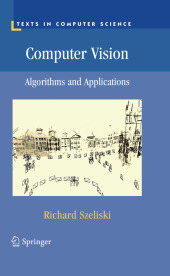 Neuerscheinungen 2011Stand: 2020-01-07 |
Schnellsuche
ISBN/Stichwort/Autor
|
Herderstraße 10
10625 Berlin
Tel.: 030 315 714 16
Fax 030 315 714 14
info@buchspektrum.de |

Richard Szeliski
Computer Vision
Algorithms and Applications
2011. XX, 812 p. 14 SW-Abb., 560 Farbabb. 28 cm
Verlag/Jahr: SPRINGER, BERLIN 2011
ISBN: 1-84882-934-5 (1848829345)
Neue ISBN: 978-1-84882-934-3 (9781848829343)
Preis und Lieferzeit: Bitte klicken
Computer Vision: Algorithms and Applications explores the variety of techniques commonly used to analyze and interpret images. It also describes challenging real-world applications where vision is being successfully used, both for specialized applications such as medical imaging, and for fun, consumer-level tasks such as image editing and stitching, which students can apply to their own personal photos and videos.
More than just a source of "recipes," this exceptionally authoritative and comprehensive textbook/reference also takes a scientific approach to basic vision problems, formulating physical models of the imaging process before inverting them to produce descriptions of a scene. These problems are also analyzed using statistical models and solved using rigorous engineering techniques.
Topics and features: structured to support active curricula and project-oriented courses, with tips in the Introduction for using the book in a variety of customized courses; presents exercises at the end of each chapter with a heavy emphasis on testing algorithms and containing numerous suggestions for small mid-term projects; provides additional material and more detailed mathematical topics in the Appendices, which cover linear algebra, numerical techniques, and Bayesian estimation theory; suggests additional reading at the end of each chapter, including the latest research in each sub-field, in addition to a full Bibliography at the end of the book; supplies supplementary course material for students at the associated website, for an upper-level undergraduate or graduate-level course in computer science or engineering, this textbook focuses on basic techniques that work under real-world conditions and encourages students to push their creative boundaries. Its design and exposition also make it eminently suitable as a unique reference to the fundamental techniques and current research literature in computer vision.
Introduction.- Image Formation.- Image Processing.- Feature Detection and Matching.- Segmentation.- Feature-based Alignment.- Structure from Motion.- Dense Motion Estimation.- Image Stitching.- Computational Photography.- Stereo Correspondence.- 3D Reconstruction.- Image-based Rendering.- Recognition.
From the reviews:
"This large work by Szeliski (Microsoft Research), an experienced computer vision researcher and instructor, contains hundreds of glossy color photos that illustrate the variety of techniques used to analyze and interpret images. ... It is suitable for teaching a senior-level undergraduate course in computer vision or graduate courses covering the more demanding material. Its primary use will be as a general reference to the fundamental techniques and recent research literature for graduate students, faculty/researchers, and professionals. Summing Up: Recommended. Upper-division undergraduates and above." (C. Tappert, Choice, Vol. 48 (9), May, 2011)
"The aim of this book is to provide a course in computer vision for undergraduate students in computer science or electrical engineering. ... The focus is on algorithms and applications. ... The mathematics covered is nicely presented ... . Each chapter contains exercises and references to additional reading. ... The book also contains many references to resources on the Internet." (Lisbeth Fajstrup, Zentralblatt MATH, Vol. 1219, 2011)
"The main interests of Richard Szeliski´s book is to give a ... up-to-date overview of the state of the art. ... a valuable resource for teaching computer vision at either the undergraduate or graduate level. ... an interesting read for any student or engineer who wants a broad introduction to the field of computer vision. ... From a teaching point of view, the book is a valuable resource, offering an extended list of exercises, project proposals, and appealing applications of computer vision techniques." (Sebastien Lefevre, ACM Computing Reviews, July, 2011)


